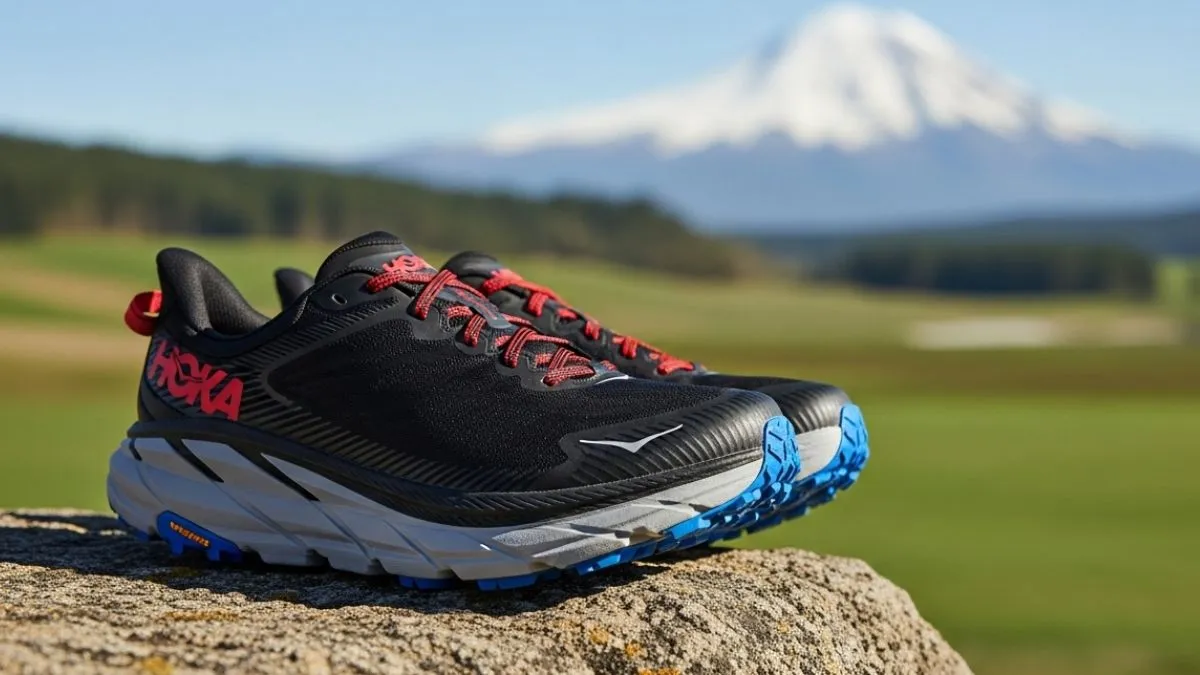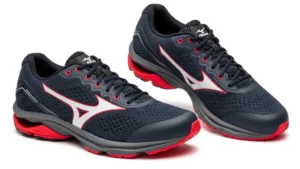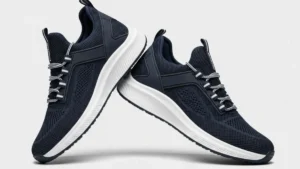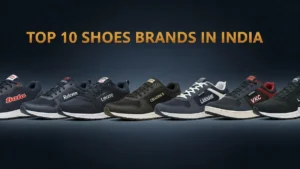
Quick Answers to Common Questions
What’s the best Hoka trail running shoe for comfort?
The best Hoka trail running shoe for comfort is the Hoka Stinson ATR. It has maximum cushioning, a wide platform for stability, and a forgiving fit that works for long-distance runs. Runners with joint sensitivity or foot fatigue often choose it for its plush yet supportive feel.
If comfort is your top priority, the Stinson ATR works well on a mix of surfaces. Its midsole foam keeps impact low, while the roomy toe box helps on longer runs. Adding a breathable upper also means less sweat build-up, which can prevent blisters.
Which Hoka shoe has the best grip?
The best Hoka shoe for grip is the Hoka Speedgoat. Its Vibram Megagrip outsole and multi-directional lugs give reliable traction on wet rocks, loose dirt, and uneven terrain. Many trail runners use it for steep climbs and technical descents where slip risk is high.
The Speedgoat’s grip works across dry, muddy, and snowy paths. Its rubber compound stays tacky in both heat and cold, while the aggressive tread pattern grips into the ground. This makes it a strong choice for runners who tackle variable weather and terrain.
Which Hoka shoe is best for speed?
The best Hoka shoe for speed is the Hoka Torrent. It’s lightweight, responsive, and offers enough cushioning to keep legs fresh without slowing turnover. The low-profile design encourages quick strides, making it a favourite for trail races and fast training runs.
The Torrent combines a nimble feel with enough grip for race-day conditions. Its midsole foam gives bounce without feeling soft, so you keep momentum on climbs and flats. This shoe works best for runners who want pace without losing trail-ready traction.
Why Hoka Trail Running Shoes Stand Out
Unique cushioning for long runs
Hoka trail shoes stand out for their oversized midsole cushioning, which absorbs impact and reduces strain during long runs. This design helps runners cover more miles with less fatigue, especially on rocky or uneven surfaces. It’s a core reason endurance athletes trust the brand for ultramarathons.
The cushioning comes from thick EVA foam that compresses with each step, softening landings. This extra layer doesn’t feel squishy but instead provides a stable platform. For runners clocking high weekly mileage, it can mean fewer sore joints and quicker recovery.
Midsole design for support
Hoka’s midsoles are shaped with a rocker profile that naturally rolls your foot forward, supporting a smooth stride. The wide base improves balance, reducing ankle rolls on trails with sudden drops or loose footing.
This design works almost like a gentle push forward. By guiding the foot, it keeps energy use efficient and helps maintain form over hours of running. On tricky trails, that extra stability can prevent costly missteps.
Lightweight build without losing stability
Hoka trail shoes use lightweight foams and breathable uppers to cut weight while keeping the structure firm. This means you get a fast feel without the shoe collapsing under pressure on tough terrain.
The materials shed ounces without sacrificing the elements that matter for support. The result is a shoe that feels agile but doesn’t wobble when side forces hit, like on a cambered slope or sharp switchback.
Comfort Features That Make a Difference
Plush cushioning technology
Hoka trail shoes use thick EVA midsoles that deliver a soft yet stable feel, reducing joint stress over long distances. This cushioning balances impact protection with a secure base, making it ideal for runners who face steep climbs and rocky descents.
Unlike flat foams, Hoka’s cushioning molds slightly to your stride without feeling spongy. It absorbs repeated shock, helping you finish long runs with less muscle fatigue. Runners often notice fewer aches after back-to-back trail days.
Breathable upper materials
Hoka trail shoes feature mesh uppers that let air flow freely, keeping feet cooler and reducing moisture build-up. This ventilation helps limit blisters and discomfort during long runs in warm or humid conditions.
The mesh is reinforced with overlays for structure, so breathability doesn’t mean a weaker shoe. In wet weather, this design also lets the shoe dry faster, cutting down on that heavy, waterlogged feel.
Fit and sizing tips for comfort
Most Hoka trail shoes fit true to size, but runners with wider feet often benefit from the wide-fit options. A snug heel and roomy toe box give secure footing without squeezing the forefoot.
Trying them on with your preferred trail socks is the best way to ensure comfort. Keep in mind that swelling happens on long runs, so a little extra toe space can prevent nail damage or hotspots.
Grip That Handles Any Terrain
Outsole patterns for traction
Hoka trail shoes use multi-directional lug patterns that bite into dirt, rock, and loose gravel. These patterns give solid footing on climbs and descents, reducing slip risk across different trail types.
The lugs vary in depth, with deeper ones for mud and shallower ones for speed on packed trails. This balance means the same shoe can handle both smooth forest paths and technical mountain routes.
Rubber compounds for durability
Hoka’s Vibram Megagrip and Durabrasion rubbers are built to resist wear while keeping their tackiness. This ensures a steady grip over hundreds of miles, even when surfaces change.
The compounds hold their bite in both heat and cold, unlike some rubbers that harden or soften too much. For trail runners logging big mileage, this means fewer outsole replacements and consistent performance.
How grip changes in wet vs dry conditions
Grip generally increases on dry surfaces and decreases on wet ones, but Hoka’s outsole designs keep traction high even in rain or snow. The key is lug placement that channels water away and rubber that stays sticky when damp.
On slick rocks, the softer rubber edges adapt to uneven shapes for more contact. In mud, wide lug spacing helps shed debris so the outsole doesn’t clog and lose traction.
Speed-Boosting Design Elements
Rocker profile for forward momentum
Hoka’s Meta-Rocker design curves the sole to roll your foot forward naturally, helping you maintain pace with less effort. This shape reduces braking forces, keeping momentum on both flats and climbs.
It’s especially useful on long runs where fatigue slows stride turnover. The rocker helps conserve energy, making each step feel smoother and quicker without extra push-off force.
Midsole responsiveness for faster strides
Hoka trail shoes use foams tuned for rebound, meaning they spring back quickly after each step. This responsiveness adds a light “pop” to your stride, aiding in quicker acceleration.
The combination of cushioning and bounce prevents the shoe from feeling sluggish. On race day or during speed workouts, this can make the difference between keeping up or fading in the last stretch.
Balancing speed with comfort
Hoka balances speed by pairing responsive midsoles with enough cushioning to protect against impact. This blend means runners can push pace without sacrificing joint comfort over rough terrain.
Shoes like the Torrent or Zinal show this balance best—lightweight for speed, yet cushioned enough for rocky trails. It’s a middle ground that works for both short sprints and longer races.
Best Hoka Trail Running Shoes in 2025
Hoka Speedgoat for technical trails
The Hoka Speedgoat remains the top choice for technical trails in 2025. It offers deep Vibram Megagrip lugs, a stable midsole, and enough cushioning for ultramarathons. It’s built for steep climbs, rocky paths, and unpredictable terrain where secure footing is critical.
The Speedgoat’s wider forefoot in newer versions adds comfort without losing precision. Its outsole can handle mud, loose gravel, and snow, making it one of the most versatile technical trail options.
Hoka Torrent for lightweight racing
The Hoka Torrent is the go-to option for runners chasing speed on race day. It’s lightweight, low-profile, and built with responsive foam that encourages quick turnover without losing trail grip.
It works well for distances up to 50K, especially when the route mixes fast singletrack and mild climbs. The streamlined upper also cuts down on bulk, helping maintain pace in competitive settings.
Hoka Challenger for all-around use
The Hoka Challenger offers a balanced mix of cushioning, grip, and speed, making it ideal for runners who want one shoe for various trail types. Its outsole can handle light mud, gravel, and road sections.
It’s a solid choice for those who split time between trails and pavement. The Challenger’s midsole keeps runs smooth, while the outsole’s moderate lugs ensure grip without feeling heavy.
How to Choose the Right Pair
Matching shoe type to terrain
Choose a Hoka trail shoe that matches your primary terrain. Technical trails need aggressive lugs and stability, while smoother paths benefit from lighter, faster models. Picking the wrong type can cause discomfort and reduce performance.
If your runs often involve mud and rocks, models like the Speedgoat are ideal. For mixed trails and road sections, the Challenger fits better. Race-focused runners on dry trails will find the Torrent more efficient.
Comfort vs performance balance
Balancing comfort and performance means selecting a shoe with enough cushioning for your distance without losing the responsiveness you need for speed. Too much cushion can slow turnover, while too little can cause fatigue.
Long-distance runners often choose the Stinson or Speedgoat for plush protection, while those doing shorter, faster efforts may prefer the Torrent or Zinal. Your typical weekly mileage can help guide this choice.
Budget considerations without sacrificing quality
Set a budget but aim for the highest-quality model you can afford, as trail shoes face heavy wear. Cheaper shoes may wear out faster, costing more over time.
Look for past-year models or sales on reputable sites to save money without giving up performance. Even older Hoka designs maintain solid cushioning and grip compared to budget trail shoes from other brands.
How to Choose the Right Pair
Matching shoe type to terrain
Choose a Hoka trail shoe that matches your primary terrain. Technical trails need aggressive lugs and stability, while smoother paths benefit from lighter, faster models. Picking the wrong type can cause discomfort and reduce performance.
If your runs often involve mud and rocks, models like the Speedgoat are ideal. For mixed trails and road sections, the Challenger fits better. Race-focused runners on dry trails will find the Torrent more efficient.
Comfort vs performance balance
Balancing comfort and performance means selecting a shoe with enough cushioning for your distance without losing the responsiveness you need for speed. Too much cushion can slow turnover, while too little can cause fatigue.
Long-distance runners often choose the Stinson or Speedgoat for plush protection, while those doing shorter, faster efforts may prefer the Torrent or Zinal. Your typical weekly mileage can help guide this choice.
Budget considerations without sacrificing quality
Set a budget but aim for the highest-quality model you can afford, as trail shoes face heavy wear. Cheaper shoes may wear out faster, costing more over time.
Look for past-year models or sales on reputable sites to save money without giving up performance. Even older Hoka designs maintain solid cushioning and grip compared to budget trail shoes from other brands.
Care and Maintenance Tips
Cleaning your Hoka shoes properly
Clean Hoka trail shoes by removing insoles and laces, rinsing off mud with cool water, and scrubbing gently with a soft brush and mild soap. Avoid machine washing, as it can damage the materials.
After cleaning, let them air dry away from direct heat. This prevents glue breakdown and keeps the midsole foam from hardening.
When to replace trail running shoes
Replace Hoka trail shoes every 300–500 miles, or sooner if grip and cushioning noticeably decline. Worn midsoles and flattened lugs can lead to discomfort and higher injury risk.
Track mileage using a running app, and watch for signs like uneven tread wear or a “dead” feeling underfoot. Both indicate the shoe’s performance is compromised.
Storage tips to extend lifespan
Store Hoka trail shoes in a cool, dry place with good air circulation. Avoid leaving them in hot cars or damp spaces, as heat and moisture weaken the glue and materials.
If storing long-term, stuff them with paper to help maintain shape. Keeping them clean before storage also prevents odors and fabric breakdown.
Final Buying Advice
Prioritising fit and terrain needs
Always prioritise a secure fit and terrain-specific features when buying Hoka trail shoes. The right combination reduces injury risk, improves performance, and keeps you comfortable over long distances.
Choose snug heel support with enough toe room for descents. Match lug depth to your terrain — deeper for technical, shallower for mixed trails. Comfort should never be sacrificed for style.
Testing shoes before committing
Test Hoka trail shoes in-store or during a retailer’s return window to confirm fit, grip, and responsiveness before committing. Even the best model won’t perform if it doesn’t suit your foot shape.
Try running in them for a short session on varied terrain if possible. Pay attention to hotspots, pressure points, or slipping, as these issues only get worse over time.




